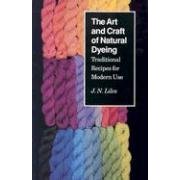How can I dye with foods such as blueberries?
How can I dye with foods such as blueberries?
Name: Heidur (Heather in English)
—ADVERTISEMENTS—
Books About Natural Dyes
The Art and Craft
of Natural Dyeing:
Traditional Recipes for Modern Use
by Jim Liles
Country or region: Iceland, Reykjavik
Message: hello
I'm trying to color with blueberries; the Icelandic wild blueberry has a beautiful color, stronger then other blueberries. The look I am going for is like spots of the blue purple that the berries give. Also, can you give me information on how to use food as a dye? Spinach, for example, has a beautiful color.
What do you want to dye? I do not recommend using blueberries or spinach to dye clothing that will be washed. To be used as a dye, it's not enough for a substance to have a beautiful color; it must also have an affinity for the material you want to dye with it, so that it clings to it, and it must resist fading due to light, oxygen, or necessary laundering.
Foods can make lovely dyes for projects that will not be washed, if they are not expected to last very long. You should dye textile fibers with food only if you enjoy the temporary nature of these colors. Don't use foods as dyes if you want your results to stay bright for a long time or to resist laundering, as is necessary for a good clothing dye.
Blueberries are colored with natural anthocyanins, while spinach is colored with chlorophyll. These colors are beautiful in the fresh food, but they turn dull when applied to textiles. For a thousand years, people have preferred to use indigo to dye clothing a blue color, because indigo is a much longer-lasting, brighter blue dye. To dye clothing or tapestries a green color, it is traditional to use indigo plus a natural yellow dye to make the green, because the green of chlorophyll that is found in the leaves of plants does not stay green, but instead turns brown.
Indigo is such a desirable natural blue dye that it has been found in as many as fifty different species of plants around the world, having been rediscovered repeatedly by different groups of people in different parts of the world.
The blue dye in blueberries must be protected from changes in pH, such as are caused by laundry soap and human perspiration, because the color changes completely according to the pH of its surroundings. Indigo is a far more practical natural dye than the coloring in blueberries.
If you want to replicate the effect of the beautiful Icelandic blueberries on textile fibers using natural dyes, I recommend that you use natural indigo, and then, if the color is not purple enough, overdye it with a little bit of a natural red dye such as madder or cochineal, which, unlike indigo, should be mordanted with a metal salt such as alum. Indigo, a vat dye, is a difficult dye for beginning dyers to work with; if you are not experienced in dyeing, I strongly recommend that you start by using commercial acid dye on wool, or a fiber reactive dye on cotton and other plant fibers.
(Please help support this web site. Thank you.)
(Please help support this web site. Thank you.)
Posted: Thursday - December 30, 2010 at 09:11 AM
Follow this blog on twitter here.
Quick Links
- All About Dyes & Dyeing Top -
- Top of this blog -
- FAQ -
- The Dye Forum -
- How to Tie Dye - How to Batik -
- Books - Toys - Plants -
- Top of this blog -
- FAQ -
- The Dye Forum -
- How to Tie Dye - How to Batik -
- Books - Toys - Plants -
More in this category:
- -
Statistics
Total entries in this blog:
Total entries in this category:
Published On: Aug 29, 2012 02:49 PM
Total entries in this category:
Published On: Aug 29, 2012 02:49 PM

